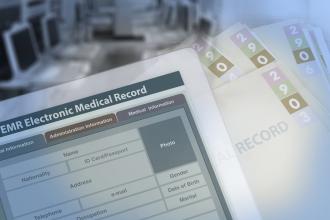Experiences from the front line of FP EMR adoption
Approximately half of the 5500 eligible BC physicians in community-based practice have now adopted an EMR through the support of PITO or their health authority, or on their own.
Approximately half of the 5500 eligible BC physicians in community-based practice have now adopted an EMR through the support of PITO or their health authority, or on their own. Notably, the adoption rate among large full-service family practice clinics (six or more physicians in group practice) has reached 90%, and almost 75% among all clinics in the smaller non-urban communities—particularly in the communities that have formed active divisions of family practice.
This update provides a snapshot of two physicians from different parts of the province on their electronic journeys to enhancing clinical value and better patient care through their participation and leadership in the Practice Support Program, Divisions of Family Practice, and in adopting the EMR.
Dr Ken Burns, part of a family practice in Maple Ridge, is an enthusiastic EMR user who also gladly facilitates ongoing learning with physician colleagues both within the region and across the province. Since 2006 Dr Burns and his colleagues at the Westgate Clinic have been working with an EMR, gradually eliminating paper by scanning in data from paper charts (some going back 30 years).
One of the first considerations they tackled was the change of practice when it came time to greet patients with a computer screen and keyboard instead of a paper chart. “We designed our patient rooms so that the computer screen wasn’t a barrier, but rather a strategically placed tool that would be easily visible to patients. When it was time to stop using the paper charts, we had to learn to trust the system, to know that all of the information that we needed was just a few clicks away. It was a temptation to bring in the chart as backup, but we didn’t and so our uptake in using the system was accelerated,” he says.
Beyond the implementation of his clinic’s EMR, Dr Burns is also a committed physician peer mentor. This sharing of knowledge happens frequently as he and others host regional physicians and MOA staff with monthly sessions that spark lively exchanges.
“Although we have been working with an EMR since 2006, there is always something to learn, such as new shortcuts or discovering functionalities that I hadn’t thought about previously,” says Burns. In addition, he has also worked with several clinics in Nanaimo, Terrace, and White Rock to share his EMR expertise.
Meanwhile in Powell River, Dr Bruce Hobson, in practice for 28 years, was a long-time computer user (he began in 1993 using the Internet for searches, maintaining a database of patient problems such as allergies and medications, for example). He moved to an EMR in 2008 as one of the first adopters of the PITO-qualified EMR solutions.
Dr Hobson says that “The biggest challenge was entering in the data from the paper chart in a meaningful way so that the EMR would become useful to me as quickly as possible. I decided to do most of the data entry myself so that I could decide specifically what I wanted to add as discrete information, such as entering problems, meds, labs, and investigations, and what I wanted to have scanned.”
Dr Hobson and his staff cite many EMR benefits: controlling all aspects of practice including scheduling, more coordinated preparation of patients’ visits by arranging lab tests and investigations according to the criteria for population goals and specific disease goals (e.g., A1Cs for diabetics, TSH for people on thyroid meds), and ensuring lab results are available for discussion during the patient visit.
He describes another important benefit: “We can access our EMR from anywhere with a computer connection to the Internet. This has been an incredible value when you get phone calls at home from patients or health care workers or when you just want to do some follow-up tasks from home. This allows me to get home earlier,” he adds.
Dr Hobson’s advice for fellow physicians who have not yet tested the EMR waters is simple: “Be patient but just do it! Take the time to enter your historical data properly. Get help from support groups such as PITO’s Communities of Practice and local physician peer mentors.”
In addition to Drs Burns and Hobson, there are approximately 35 other physician mentors across BC who are happy to provide support and counsel to those at any stage of EMR adoption. To contact someone in your area, contact your local PITO relationship manager (see Contact Us at www.pito.bc.ca), or Valerie Woods, peer champion program manager at valerie.woods@pito.bc.ca.
—Jeremy Smith Program Director
Physician Information Technology Office
hidden
This article has not been peer reviewed.

